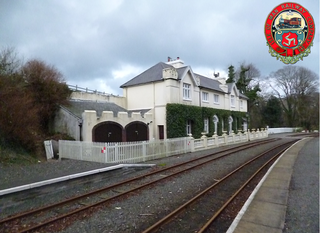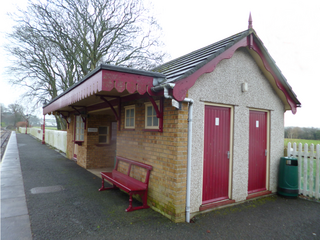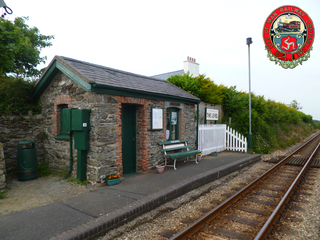
The Isle of Man Railway (IMR) is a narrow gauge steam-operated railway connecting Douglas with Castletown and Port Erin in the Isle of Man. The line is 3 ft narrow gauge and 15+1⁄2 miles long. It is the remainder of what was a much larger network that also served the western town of Peel, the northern town of Ramsey and the mining village of Foxdale. Now in government ownership, it uses original rolling stock and locomotives and there are few concessions to modernity.

Colby railway station is a small railway station on the southern edge of the village of Colby in the south of the Isle of Man served by the Isle of Man Railway; it forms part of the sole remaining section of the network which once covered over 46 miles island-wide.

Port Soderick Railway Station is the first station on the Port Erin line of the Isle of Man Railway and is located near the settlement of the same name on the Isle of Man. It forms part of the sole remaining section of the railway which once served a 46-mile network across the island. The station was built primarily to serve the popular coastal resort which is a short walk from the station via one of the Manx National Glens. Although largely derelict today, this resort was once a hugely popular destination for tourists

Santon Railway Station is a request stop near Newtown in the parish of Santon, Isle of Man; it forms part of the sole remaining line of the Isle of Man Railway which once encompassed over 46 miles of network and retains its original station building. The halt sometimes plays host to Santa's Grotto each December as part of the railway's Santa Trains service although between 2010 and 2013 it was not utilised for this purpose. The railway station is situated off the A5 Port Erin to Douglas road, between the railway stations of Ballasalla and Port Soderick.

Ballasalla Railway Station is located in the village of Ballasalla in the south of the Isle of Man, close to the airport, and is served on a seasonal basis by the Isle of Man Railway. It forms part of the sole remaining section of the once extensive network that operated across the island. Ballasalla was the usual crossing point for trains, making it popular with photographers, until the introduction of the 2015 timetable which saw all trains passing at Castletown.

Castletown Railway Station is an intermediate station on the Isle of Man Railway on the Isle of Man forming part of sole remaining section of the once extensive network that operated across the island. The station is the busiest of the railway's intermediate stations, being the closest to a number of local visitor attractions. In peak season service trains often pass here, making the station one of the railway's more active stopping places. The station occupies a site within walking distance of the main town and is in close proximity to the local playing fields.

The Level is a seasonally operated request stop on the Isle of Man Railway located in the sheading of Rushen on the Isle of Man. This is the sole remaining section of the railway which once spanned over 46 miles with lines to Peel in the west, Ramsey in the north and the mining village of Foxdale in the centre of the island.
The Manx Northern Railway (MNR) was the second common carrier railway built in the Isle of Man. It was a steam railway between St John's and Ramsey. It operated as an independent concern only from 1879 to 1905.
Union Mills is a village in the parish of Braddan on the A1, the primary road which connects Douglas and Peel in the Isle of Man, close to the River Dhoo.
This article details each of the lines operated by the Isle of Man Railway, including the original line to Peel in the west, opened in 1873, followed by the Port Erin line the following year, as well as the Manx Northern Railway's line between St John's and Ramsey and the Foxdale Railway's line between St John's and Foxdale.

Braddan Bridge is a bridge over the river Dhoo on the Douglas to Peel road, from which a halt on the Isle of Man Railway's first line to Peel took its name.

Crosby Railway Station was an intermediate stop on the Isle of Man Railway; it served the village of Crosby in the Isle of Man and was a stopping place on a line that ran between Douglas and Peel. It was part of the island's first railway line.

St John's Railway Station was on the Isle of Man Railway (IMR), later merging with the nearby station of the Manx Northern Railway (MNR); it was the junction of lines to Douglas, Peel, Ramsey and Foxdale. It was close to Tynwald Hill. The station began life in 1873 as the penultimate stop on the Peel Line, the island's first passenger railway line; it consisted of a simple wooden waiting shelter with accommodation for the station master, and a passing loop. This layout remained until the arrival of the new line from the north in 1879 when a second station was established, later merging with the existing one. The station was the hub of the island's railway network, where the lines to Douglas, Peel, Ramsey and Foxdale met.
Sulby BridgeRailway Station was a station on the Manx Northern Railway (MNR), later owned and operated by the Isle of Man Railway; it served the village of Sulby in the Isle of Man and was an intermediate stopping place on a line that ran between St. John's and Ramsey.

Onchan Head Halt was once the first official stopping place on the Manx Electric Railway on the Isle of Man and is less than one mile from the southern terminus of the line.
One of the characteristics of the Isle of Man Railway is the numerous level crossings and farm crossings along the various routes; many smaller crossing places are marked only by gates that criss-cross farm land and provide access to private roads connecting the farms to the main roads. Being largely rural in nature the railway has many of these scattered along the existing South Line, and there were many more on the closed sections of the railway. These can be summarised as follows, along with other points of interest along the line not covered in the Isle of Man Railway stations section:-

St Germain'sRailway Station was a station on the Manx Northern Railway in the Isle of Man, later owned and operated by the Isle of Man Railway; it served the small village of the same name and was an intermediate stopping place on a line that ran between St John's and Ramsey.
Crosby is a small village located 3+3⁄4 miles west of Douglas in the parish of Marown in the Isle of Man.

Turriff railway station was a railway station in Turriff, Aberdeenshire, Scotland. It was opened in 1857 by the Banff Macduff & Turriff Junction Railway, later part of the Great North of Scotland Railway, then the LNER and finally British Railways, on the branchline from Inveramsay to Macduff, the station closed to passengers in 1951 and to goods in 1966. The town lay to the north.

Quarterbridge is situated soon after the 1 mile-marker measured from the TT Grandstand, part of the Snaefell Mountain Course used for the Isle of Man TT races, at the junction of the primary A1 Douglas to Peel road, A2 Douglas to Ramsey road and the A5 Douglas to Port Erin road which forms the boundary between the parishes of Braddan and Onchan in the Isle of Man.



















